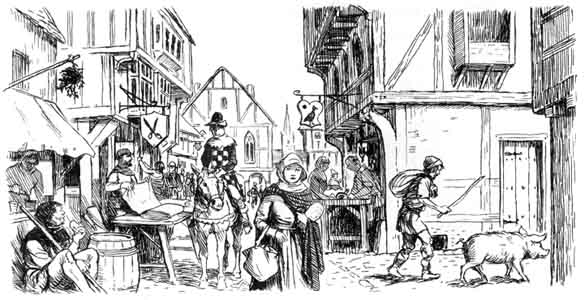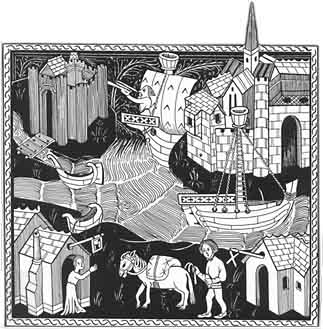

Encyclopedia | Library | Reference | Teaching | General | Links | About ORB | HOME
 Introduction to the history of medieval
boroughs
Introduction to the history of medieval
boroughs
|
Introduction menu Problems of definition | Continuity or creation? | Wiks, burhs, and ports Planned/planted towns | Growth of self-government | URBAN ECONOMY | Urban society further reading |
| The urban economy |
 |
|
A 20th-century artist's depiction of a street scene from a 14th century English town, illustrating the retailing of goods – such as cloth or (far left) cooked foods – from stalls outside of houses, the ground-floor interior being used rather for the production of goods. A reminder that agriculture still had a place in many medieval towns, however, is the ever-troublesome pig. |
 |
Drawing based on a English manuscript illustration of ca.1400, touching upon aspects of the economic system. In the foreground a packhorse, loaded with merchandize, is driven towards an inn (with welcoming hostess); a network of inns across the country was important for commerce. The building at lower right, with hanging sign indicating it some kind of commercial or industrial establishment, may represent a craft workshop that produced some of the goods being transported by the horse. At rear right, the artist has depicted a walled town, location of major marketplaces for goods, while at left stands a castle or fortifed manor-house – residence of aristocracy who were consumers of luxury goods imported by merchants. The packhorse reflects the role of land-based transportation in the economy, while the ships and boats represent the importance of water transportation. |
 previous |
 main menu |
 next |
| Created: April 5, 1999. Last update: December 28, 1999 | © Stephen Alsford, 1999-2003 |
|
Encyclopedia | Library | Reference | Teaching | General | Links | Search | About ORB | HOME The contents of ORB are copyright © 2003 Kathryn M. Talarico except as otherwise indicated herein. |